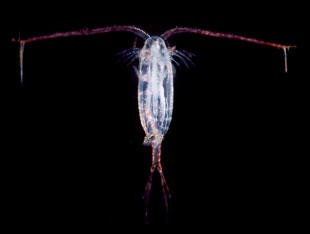Interactions
Kryptophanaron alfredi is a luminescent fish.
There are many bioluminescent organisms that can be found
throughout the world including bioluminescent algea (ie.
Gonyaulax polyedra), bioluminescent insects (ie.
Photinus ignitus), bioluminescent
dinoflagellate (ie.
Noctiluca scintillans) and many more. There
are many ways that organisms can produce their
luminescent feature. The Kryptophanaron alfredi
gets its luminosity from its mutualistic relationship
with bacteria part of the genus Photobacterium,
Lucibacterium, and Vibrio (Herish, 1982). Another
example of a bacteria that is part of the Vibrio genus
is the
Vibrio salmonicida. The bacteria
provide the light source that helps the Kryptophanaron
alfredi find food, in return Kryptophanaron alfredi
provides protection for the bacteria. In the
family Anomalpidae, flashlight fish, bacteria live within
light organs that are made primarily of tubules, and
bacteria are found specifically in the lumen of the
those tubules (Haygood, 1990).
In Kryptophanaron alfredi, the bacteria are found in
light organs, called photophores, in the fish that are located
near the head of the fish and are blue-green in color,
similar to the color of light the bacteria emits (Colin
et al., 1979). The photophores are able to block the
light emissions by either blocking the light with a
black sheet like structure that moves up over the organ
from the bottom of the organ, or by rotating the organ
so the light does not shine outwards (Herrish, 1982).
The bacteria that live in Anomalopidae can move in and
out of the photophore through pores that are located in
the surface of the photophore (Haygood, 1990). The
surface of the photophore is thin and relatively
transparent which makes it easier for the transportation
of the bacteria across the surface (Colin et al., 1979).
The bacteria in the light organ produce an enzyme that
produces light and provide the light for the
Kryptophanaron alfredi (Haygood 1990).

The Kryptophanaron alfredi finds its food mainly in
the depths of the ocean where little sunlight is
reached. It is
thought to use its luminosity to find food. During the
day the fish receeds to deeper locations, and continues
to use its light to see its prey (Colin et al., 1979). The
Kryptophanaron alfredi eats mainly shrimp and copepod
which are located in the benthic zone (read more in
habitat)
(Colin et al. 1979). The bacteria provide the
light source that helps the Kryptophanaron alfredi find
food.
Figure 1. Copepod. Kils 2004.